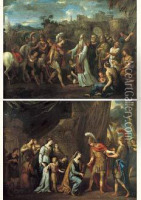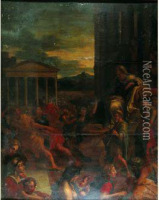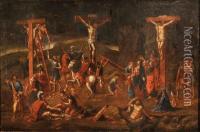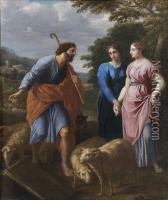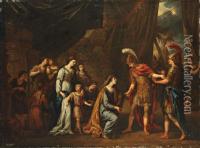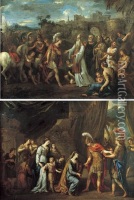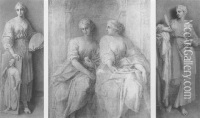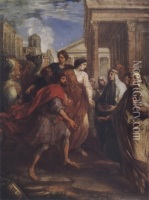Arnould De Vuez Paintings
Arnould de Vuez was a distinguished French painter born in 1644 in Saint-Omer, a commune in the Pas-de-Calais department in northern France. Known for his historical paintings, portraits, and religious compositions, de Vuez demonstrated a remarkable ability to capture the essence of his subjects with both grandeur and sensitivity. His work is characterized by its vivid detail, rich colors, and the dynamic composition of figures within his paintings, which have contributed to his recognition as an important figure in 17th-century French art.
De Vuez embarked on his artistic journey at a young age, showing a profound interest and natural talent in painting. Seeking to refine his skills, he traveled to Paris, where he became a student of Charles Le Brun, the leading French artist of the time and the principal painter to King Louis XIV. Under Le Brun’s tutelage, de Vuez honed his craft, absorbing the influences of the French baroque style, which emphasized movement, color, and sensuality. However, de Vuez's ambition and quest for artistic growth led him beyond the confines of France.
In the late 1660s, de Vuez ventured to Italy, spending time in Rome and other significant cultural centers. This period was crucial in shaping his artistic identity; the exposure to Italian art, especially the works of Caravaggio and the Bolognese School, deeply influenced his approach to painting. De Vuez's style evolved, integrating the dramatic chiaroscuro and emotional intensity he observed in Italian masterpieces with the elegance and grandeur of French art.
Upon his return to France, Arnould de Vuez established himself as a sought-after artist, receiving commissions from the church, the nobility, and the royal court. His works during this period reflect a mature amalgamation of his French roots and Italian influences, making him a unique bridge between the two traditions. Despite his success, detailed records of his life and career from this point onwards are somewhat sparse, a common issue for many artists of his time. Nevertheless, his surviving works continue to be studied and admired for their artistic merit and historical value.
Arnould de Vuez passed away in 1720, leaving behind a legacy that has endured through the centuries. His paintings remain a testament to the cultural exchange between France and Italy in the Baroque era and showcase the richness of 17th-century European art. De Vuez is remembered not only for his contributions to the artistic movements of his time but also for his role in the broader narrative of European art history.
